
Welcome to the Best National Parks in Europe
Stunning parks shockingly close to Venice, Prague, Berlin, etc.
When you think of national parks, it’s easy to think of the Grand Canyon, Yosemite, or Zion. But we shouldn’t be so hemisphere-centric. Indeed, there’s a whole cohort of European international parks that should be on everyone’s bucket list, from hardcore outdoorsy-types to those just starting to dip their toes in.
Though some are more isolated than others, due to the continent’s population density, Europe’s parks are generally more easily reachable than their American counterparts. This makes many of them easy day trips from popular tourist cities rather than multi-day affairs. Though the overlapping bureaucratic authorities of all of Europe’s various countries and institutions means that some of these are not technically national parks, they’re all worthy of the honorary distinction. Here are eight of the best.
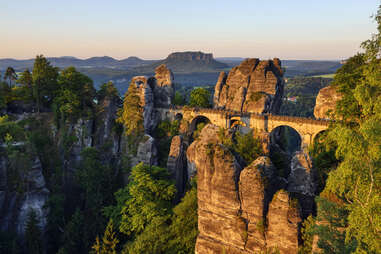
Germany and Czechia
Straddling the German-Czech border just outside of Dresden are the mountains of the oddly-named Saxon Switzerland National Park (Nationalpark Sächsische Schweiz in German, Národní park České Švýcarsko in Czech). Though these peaks may not quite rival the Alps in scale, they’re more than a match when it comes to majestic grandeur. These dramatic sandstone cliffs have inspired artists and mountain climbers alike for centuries. Foremost among these is the Bastei, a jagged formation of finger-like rock pillars linked together by an unlikely stone bridge towering almost 200 meters (650 feet) above the Elbe valley below.
A favorite destination of hikers, mountain bikers, and rock climbers (the park boasts some 14,000 climbing routes), the park can be reached easily from Dresden, Berlin, and Prague. Though renting a car is the easiest, train enthusiasts can travel from Dresden or Prague central stations to Bad Schandau National Park Bahnhof. From there, take a short ferry ride across the Elbe and board the bus to the park entrance. Visitors from Berlin will need to reach the park via Dresden Central Station.
Pro tip: Though the park is open year round, visit in autumn to take in the spectacular fall foliage.
Nearby cities: Dresden, Berlin, Prague

Iceland
Almost 1,100 years ago, a bunch of Vikings met in a field in Iceland to make decisions on the pressing issues of their time. This meeting eventually became a regular event, and so the Althing—the world’s first parliament—was born. In 1930, the parliament of Iceland celebrated the 1,000th anniversary of the first Althing by dedicating the Þingvellir National Park (also spelled Thingvellir), a 35-square-mile (90 km2) reserve smack in the middle of Iceland’s habitable area.
Though small by global standards, it packs a punch; in addition to the hiking trails you expect from a national park, Þingvellir boasts horseback riding, fishing, and even scuba diving. In 1789, an earthquake caused deep fissures to open up all around the land, forming gorges that quickly filled with Iceland’s pristine groundwater. And because Þingvellir straddles the boundary between the Eurasian and North American tectonic plates, this is the only place in the world where divers can breaststroke their way between two tectonic plates. Reaching Þingvellir is easy: it’s perhaps the most prominent stop along Iceland’s well-touristed Golden Circle and a quick 30-mile (50 km) drive from the capital of Reykjavik.
Pro tip: Due to its small size and huge popularity, Iceland is best visited in the off season: May and September boast relatively warm temperatures while avoiding the summer crush. This goes double for popular sites like Þingvellir.
Nearby cities: Reykjavik
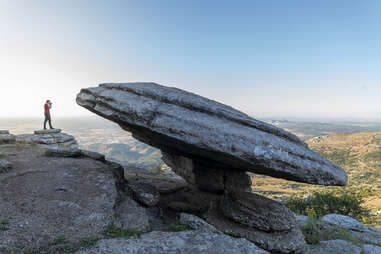
Spain
About 150 million years ago, the land that would become Spain was a vast inland sea where millions of clams, snails, and various slimy, shelled animals lived and died. Flash forward to the present day, and their remains have fossilized and eroded into a stunning limestone karst landscape smack-dab in the center of Spain’s Andalusia autonomous community. El Torcal, just outside the city of Antequera and easily reachable from Sevilla, Malaga, and Granada, offers tourists stunning views of bizarre rock formations, rare wildlife, and prehistoric tombs.
The park is crisscrossed by well-marked trails that take hikers past naturally-sculpted rock formations. Popular sights include interesting stone formations like el Sombrero, la Jarra, or the Cathedral. If you get lucky, you may spot an elusive Iberian ibex climbing the jagged stones or a griffon vulture soaring high above.
Pro tip: It’s easy to get lost in the maze-like warren of limestone formations, so don’t stray too far off the well-marked routes.
Nearby cities: Malaga, Granada, Sevilla, Cordoba

Croatia
It’s been a few years since Game of Thrones catapulted Croatia into its much-deserved spot near the top of world tourism destinations, and perhaps the buzz has subsided somewhat, but there’s so much more to this jewel of the Adriatic than King’s Landing (AKA Dubrovnik). And high on anyone’s list should be the Plitvice Lakes National Park. If you’re a travel nerd—and let’s face it, you’re reading this—you’ve maybe already seen pictures of the brilliantly turquoise pools and waterfalls latticed by wooden causeways and boardwalks before. And let us tell you, they aren’t any less impressive in person.
Though swimming isn’t allowed, the walkways that crisscross the park’s 16 named lakes and innumerable unnamed, smaller lakes give you ample chance to take it all in. But even though the lakes are the star of the show, they represent only 1% of the park’s protected area—the park also offers several well-marked hiking trails of varying difficulty, and the roads surrounding the park are also popular with cyclists.
Pro tip: If you really can’t resist the urge to take a dip, head to the smaller Krka National Park nearby, where swimming is allowed in several of the lakes.
Nearby cities: Zagreb, Split
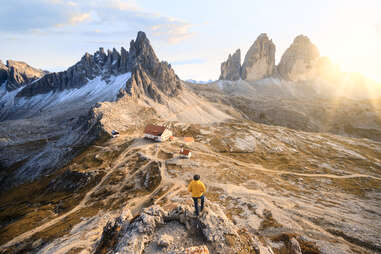
Italy
While far from undiscovered, South Tyrol is one of Italy’s less famous regions. Nestled in the Dolomites, a section of the Alps between Italy and Austria, South Tyrol is notable for its unique culture, cuisine, and landscape. And nowhere is the landscape of the Dolomites more on display than in Tre Cime di Lavaredo, named after the UNESCO-recognized rock formation it conserves. As with many parks on this list, it has several well-marked hiking trails.
Tre Cime di Lavaredo’s main hike is an easy six-mile (10 km) stroll through mostly flat terrain, roughly circling the park’s main attraction. And what an attraction it is: the three famous peaks rise more than 1,800 feet (500 meters) into the air, all of which are nearly vertical escarpments made of the slightly pinkish rock that gives the landscape its name. Along the hike, you’ll find several rifugios: small restaurants where you can stop for a beer or a bite to eat—it is Italy, after all.
Pro tip: Follow the route counterclockwise to ensure the peaks stay within your view for the majority of the hike.
Nearby cities: Venice, Innsbruck
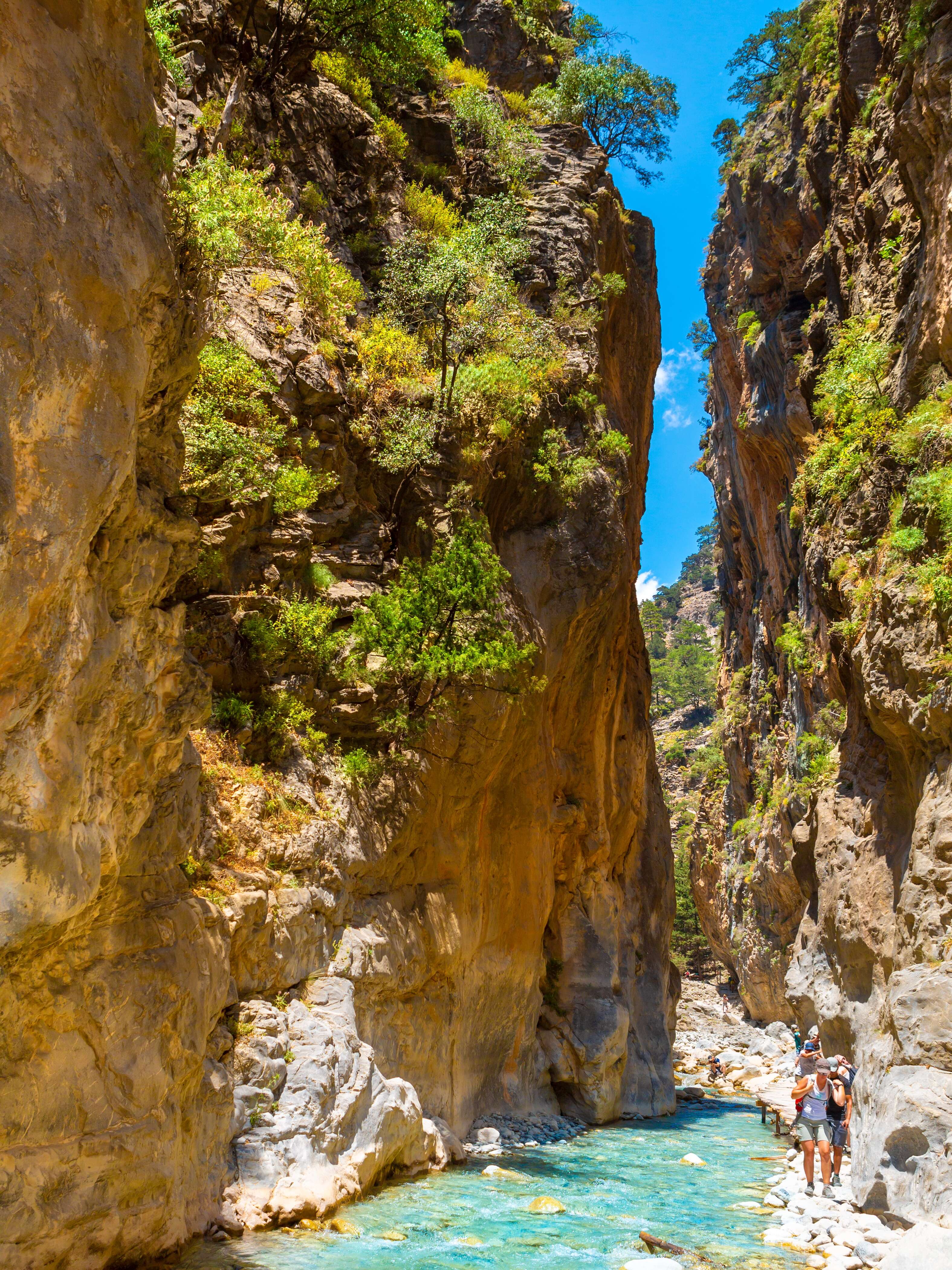
Greece
If a vacation in Greece evokes thoughts of sun-drenched beaches and sparkling turquoise waters, you’d be suprised just how diverse the landscape of this Mediterranean country can be. And nowhere is this more visible than on the island of Crete. Visitors to eastern Crete might be surprised to observe snowy mountain peaks in the distance—these are the Lefke Ori mountains: the white mountains. And there, nestled deep within their jagged peaks, lies the spectacular Samaria Gorge, one of Europe’s longest canyons.
Here, an eight-mile (13 km) hiking trail meanders down the gorge’s twisted course, crossing back and forth across the small stream that carved it. At mile seven, hikers will reach The Gates, a place where the gorge narrows to barely a few feet wide. Here, the tops of the canyon’s walls are almost 1000 feet tall, and the sky is visible only as a thin sliver of blue between them. At the end of the hike, you reach the cute fishing village of Agia Roumeli, where you can wash the sweat and dust off in the cool waters of the Libyan sea.
Pro tip: Keep an eye out for the pride of Crete: a native ungulate called a kri kri. Locals will tell you it’s similar to a goat, but actually quite different. We’re not so sure, but they make for nice scenery.
Nearby cities: Chania, Rethymno
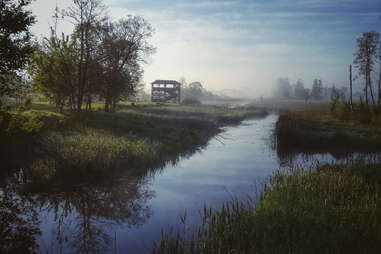
Poland and Belarus
Deep in wild eastern side of Poland, fantastic, ancient creatures lurk through a forest unchanged since time immemorial. This is the Bialowieza National Park, the last untouched remnant of Europe’s primeval forest, which once stretched from the Urals to the coast of France. The center of the park is a strictly controlled zone, home to Europe’s last wild bison herd (known as wisents), the unofficial mascot of the forest. You need a guide to visit the center, but this area only covers a small portion of the whole forest. The rest of the forest is crisscrossed by fabulous bike paths and roads.
Pro tip: Wisents are wild animals, and for this reason, they tend to avoid humans. Luckily, you can get your fill of them (literally—try the bison pierogi) at the Rezerwat Żubrów, a bison reserve involved in the conservation of the forest and its furry inhabitants.
Nearby cities: None, really, but the forest is reachable from Warsaw via a four-hour bus ride.
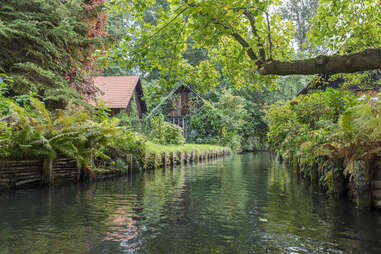
Bonus: Spreewald
Germany
After a long night partying in Berlin’s recently reopened nightclubs, it can be nice to take the edge off by relaxing in the country the next day. Located just outside of Berlin but easily reachable by train, the town of Lübbenau awaits. It’s the heart of the Spreewald, a sprawling network of marshy fields and forest crisscrossed by hundreds of canals. This swampy region, historically inhabited by a group of Slavic speakers related to Czechs, forms Berlin’s closest nature park. Rent a kayak or hire a traditional punt boat and set off through what some have called “the Venice of Germany.”
The Spreewald is known for the ostalgic pickles that are famously featured in the film Goodbye Lenin, and here you can buy them right on the side of the canal, sold by enterprising grandmas straight from the cellar. Other than that and the occasional biergarten, it’s just you, your boat, the occasional cow stopping for a drink, and the Spreewald.
Pro tip: Lübbenau is the center of the Spreewald, but the region stretches for miles. Many towns are connected by the Gürkenradweg (Pickle bike path), which can be recognized from the signs featuring a pickle riding a bike.
Nearby cities: Berlin